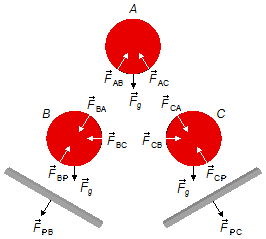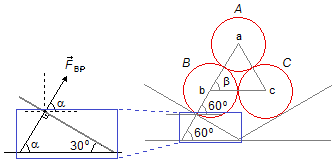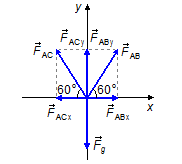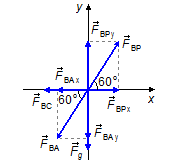Solved Problem on Static Equilibrium
advertisement
Three cylinders A, B, and C, with the horizontal axis and each weight W, are
in equilibrium on a system of two inclined planes, each with an angle of 30° relative to a plane, as
shown in the figure. Determine the magnitudes of reaction forces in each cylinder due to planes and
other cylinders.

Problem data:
- Weight of each cylinder A, B and C: W;
- Angle between the inclined and horizontal plane: 30°.
Drawing a free-bodies diagrams, we have the forces that act in each body.

Cylinder A:
- \( {\vec F}_{g} \): gravitational force;
- \( {\vec F}_{AB} \): contact force on cylinder A due to the cylinder B;
- \( {\vec F}_{AC} \): contact force on cylinder A due to the cylinder C.
- \( {\vec F}_{g} \): gravitational force;
- \( {\vec F}_{BA} \): contact force on cylinder B due to cylinder A;
- \( {\vec F}_{BC} \): contact force on cylinder B due to cylinder C;
- \( {\vec F}_{BP} \): contact force on cylinder B due to the plane.
- \( {\vec F}_{g} \): gravitational force;
- \( {\vec F}_{CA} \): contact force on cylinder C due to cylinder A;
- \( {\vec F}_{CB} \): contact force on cylinder C due to cylinder B;
- \( {\vec F}_{BP} \): contact force on cylinder B due to the plane.
- \( {\vec F}_{PB} \): contact force on the plan due to cylinder B;
- \( {\vec F}_{PC} \): contact force on the plane due to cylinder C.
Solution
The inclined plane makes an angle of 30° with the horizontal, the reaction force \( \vec{F}_{BP} \) is normal or perpendicular to the plane, making a 90° angle. Extending the line in the direction of the reaction force of the inclined plane to the horizontal plane, making an angle α (Figure 2 - highlighted in the blue rectangle). The angle between the reaction force and the horizontal is also α, are corresponding angles. As the sum of the interior angles of a triangle is equal to 180°
\[
\begin{gather}
\alpha +30°+90°=180°\Rightarrow \alpha=180°-90°-30°\Rightarrow \alpha=60°
\end{gather}
\]

Assuming the three cylinders are equals, they have the same radius, so the distance between their centers a, b, and c are equal and determine the sides of an equilateral triangle with the three equal angles. As the sum of the interior angles of a triangle is equal to 180°
\[
\begin{gather}
\beta +\beta +\beta =180°\Rightarrow 3\beta=180°\Rightarrow \beta =\frac{180°}{3}\Rightarrow\beta =60°
\end{gather}
\]
thus the contact forces between cylinders A and B
(\( {\vec F}_{AB} \)
and
\( {\vec F}_{BA} \)),
A and C
(\( {\vec F}_{AC} \)
and
\( {\vec F}_{CA} \)),
and between cylinder B or C and inclined planes
(\( {\vec F}_{PB} \)
and
\( {\vec F}_{PC} \))
make with the horizontal direction a 60° angle.Drawing the forces in a coordinate system xy, we can apply the equilibrium condition
\[
\begin{gather}
\bbox[#99CCFF,10px]
{\sum F=0} \tag{I}
\end{gather}
\]
Cylinder A
- Direction x:
\[
\begin{gather}
F_{ABx}-F_{ACx}=0
\end{gather}
\]
we have
\( F_{ABx}=F_{AB}\cos 60° \)
and
\( F_{ACx}=F_{AC}\cos 60° \)
\[
\begin{gather}
F_{AB}\cos 60°-F_{AC}\cos 60°=0 \tag{II}
\end{gather}
\]
- Direction y:
\[
\begin{gather}
F_{ABy}+F_{ACy}-W=0
\end{gather}
\]
we have
\( F_{ABy}=F_{AB}\sin 60° \)
and
\( F_{ACy}=F_{AC}\sin 60° \)
\[
\begin{gather}
F_{AB}\sin 60°+F_{AC}\sin 60°-W=0 \tag{III}
\end{gather}
\]

Figure 3
From the Trigonometry
\[
\begin{gather}
\sin 60°=\frac{\sqrt{3\,}}{2}
\end{gather}
\]
we have substituted in (III)
\[
\begin{gather}
F_{AB}\frac{\sqrt{3\,}}{2}+F_{AB}\frac{\sqrt{3\,}}{2}-W=0\\[5pt]
2 F_{AB}\frac{\sqrt{3\,}}{2}=W\\[5pt]
F_{AB}\sqrt{3\,}=W\\[5pt]
F_{AB}=\frac{W}{\sqrt{3\,}}
\end{gather}
\]
multiplying the numerator and the denominator by
\( \sqrt{3\,} \)
\[
\begin{gather}
F_{AB}=\frac{W}{\sqrt{3\,}}\times\frac{\sqrt{3\,}}{\sqrt{3\,}}\\[5pt]
F_{AB}=\frac{\sqrt{3\,}}{3}W
\end{gather}
\]
As
\( {\vec F}_{AB} \)
and
\( {\vec F}_{BA} \)
forces are a pair of action-reaction forces, they have the same magnitude but in opposite directions, as
the forces
\( {\vec F}_{AC} \)
and
\( {\vec F}_{CA} \)
\[
\begin{gather}
\bbox[#FFCCCC,10px]
{F_{AB}=F_{BA}=F_{AC}=F_{CA}=\frac{\sqrt{3\,}}{3}W}
\end{gather}
\]
Cylinder B
- Direction x:
\[
\begin{gather}
F_{BPx}-F_{BC}-F_{BAx}=0
\end{gather}
\]
we have
\( F_{BPx}=F_{BP}\cos 60° \)
and
\( F_{BAx}=F_{BA}\cos 60° \)
\[
\begin{gather}
F_{BP}\cos 60°-F_{BC}-F_{BA}\cos 60°=0
\end{gather}
\]
we have
\( F_{BA} \)
the magnitude of the reaction force on cylinder B due to cylinder A already determined.

Figure 4
From the Trigonometry
\[
\begin{gather}
\cos 60°=\frac{1}{2}
\end{gather}
\]
\[
\begin{gather}
F_{BP}\frac{1}{2}-F_{BC}-\frac{\sqrt{3\,}}{3}W\frac{1}{2}=0\\[5pt]
\frac{1}{2}F_{BP}-F_{BC}=\frac{\sqrt{3\,}}{6}W \tag{IV}
\end{gather}
\]
- Direction y:
\[
\begin{gather}
F_{BPy}-F_{BAy}-W=0
\end{gather}
\]
we have
\( F_{BPy}=F_{BP}\sin 60° \)
and
\( F_{BAy}=F_{BA}\sin 60° \)
\[
\begin{gather}
F_{BP}\sin 60°-F_{BA}\sin 60°-W=0
\end{gather}
\]
using the value of
\( F_{BA} \)
the sine of 60°
\[
\begin{gather}
F_{BP}\frac{\sqrt{3\,}}{2}-\frac{\sqrt{3\,}}{3}W\frac{\sqrt{3\,}}{2}-W=0\\[5pt]
\frac{\sqrt{3\,}}{2}F_{BP}-\frac{3}{3\times 2}W-W=0\\[5pt]
\frac{\sqrt{3\,}}{2}F_{BP}-\frac{1}{2}W-W=0
\end{gather}
\]
multiplying the expression up by 2
\[
\begin{gather}
\qquad\; \frac{\sqrt{3\,}}{2}F_{BP}-\frac{1}{2}W-W=0 \quad \text{(}\times\text{2)}\\[5pt]
\sqrt{3\,}F_{BP}-W-2W=0\\[5pt]
\sqrt{3\,}F_{BP}-3W=0\\[5pt]
\sqrt{3\,}F_{BP}=3W\\[5pt]
F_{BP}=\frac{3W}{\sqrt{3\,}}
\end{gather}
\]
multiplying the numerator and the denominator by
\( \sqrt{3\,} \)
\[
\begin{gather}
F_{BP}=\frac{3W}{\sqrt{3\,}}\times \frac{\sqrt{3\,}}{\sqrt{3\,}}\\[5pt]
F_{BP}=\sqrt{3\,}W
\end{gather}
\]
As
\( {\vec F}_{BP} \)
and
\( {\vec F}_{PB} \)
forces are a pair of action-reaction forces, they have the same magnitude but in opposite directions, as
the forces
\( {\vec F}_{CP} \)
and
\( {\vec F}_{PC} \)
\[
\begin{gather}
\bbox[#FFCCCC,10px]
{F_{BP}=F_{PB}=F_{CP}=F_{PC}=\sqrt{3\,}W}
\end{gather}
\]
substituting this value into the expression (IV)
\[
\begin{gather}
\frac{1}{2}\,\sqrt{3\,}W-F_{BC}=\frac{\sqrt{3\,}}{6}W\\[5pt]
F_{BC}=\frac{\sqrt{3\,}}{2}W-\frac{\sqrt{3\,}}{6}W
\end{gather}
\]
multiplying and dividing by 3 the first term on the right-hand side of the equation
\[
\begin{gather}
F_{BC}=\frac{3}{3}\times\frac{\sqrt{3\,}}{2}W-\frac{\sqrt{3\,}}{6}W\\[5pt]
F_{BC}=\frac{3\sqrt{3\,}W-\sqrt{3\,}W}{6}\\[5pt]
F_{BC}=\frac{2\sqrt{3\,}}{6}W\\[5pt]
F_{BC}=\frac{\sqrt{3\,}}{3}W
\end{gather}
\]
As
\( {\vec F}_{BC} \)
and
\( {\vec F}_{CB} \)
forces are a pair of action-reaction forces, they have the same magnitude but in opposite directions
\[
\begin{gather}
\bbox[#FFCCCC,10px]
{F_{BC}=F_{CB}=\frac{\sqrt{3\,}}{3}W}
\end{gather}
\]
advertisement

Fisicaexe - Physics Solved Problems by Elcio Brandani Mondadori is licensed under a Creative Commons Attribution-NonCommercial-ShareAlike 4.0 International License .